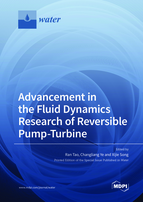Advancement in the Fluid Dynamics Research of Reversible Pump-Turbine
A special issue of Water (ISSN 2073-4441). This special issue belongs to the section "Hydraulics and Hydrodynamics".
Deadline for manuscript submissions: closed (30 September 2022) | Viewed by 22742
Special Issue Editors
Interests: water conservancy; irrigation and drainage machinery; pump and pumping station
Special Issues, Collections and Topics in MDPI journals
Interests: optimization design of fluid machinery; multiphase flow of hydraulic systems; vortex control technology of pump stations
Interests: complex flow and vortex dynamics in pump turbine
Special Issues, Collections and Topics in MDPI journals
Special Issue Information
Dear Colleagues,
Reversible pump-turbine is the key component of pumped storage power station. It has the functions of peak load regulation, phase regulation, frequency regulation and emergency standby of power grid. Fluid dynamics in reversible pump-turbine is very complex because it operates in both pump mode and turbine mode. There are many problems in the process of working condition conversion. Carrying out relevant researches are necessary for the operation stability and security of pumped storage power station. This Special Issue offers a major opportunity for reporting advancements in the fluid dynamics research of reversible pump-turbine. This Special Issue covers, but is not limited to, a wide range of topics, including:
- starting-up (Q-H curve) stability in pump mode of reversible pump-turbine;
- S-shape stability at speed no load of reversible pump-turbine;
- cavitating flow in reversible pump-turbine;
- pressure pulsation in reversible pump-turbine;
- high efficiency design of reversible pump-turbine for multiple conditions;
- structural response of reversible pump-turbine under hydraulic excitation;
- hydraulic transient process of reversible pump-turbine;
Both experimental and numerical studies are welcome.
Prof. Dr. Ran Tao
Dr. Changliang Ye
Dr. Xijie Song
Guest Editors
Manuscript Submission Information
Manuscripts should be submitted online at www.mdpi.com by registering and logging in to this website. Once you are registered, click here to go to the submission form. Manuscripts can be submitted until the deadline. All submissions that pass pre-check are peer-reviewed. Accepted papers will be published continuously in the journal (as soon as accepted) and will be listed together on the special issue website. Research articles, review articles as well as short communications are invited. For planned papers, a title and short abstract (about 100 words) can be sent to the Editorial Office for announcement on this website.
Submitted manuscripts should not have been published previously, nor be under consideration for publication elsewhere (except conference proceedings papers). All manuscripts are thoroughly refereed through a single-blind peer-review process. A guide for authors and other relevant information for submission of manuscripts is available on the Instructions for Authors page. Water is an international peer-reviewed open access semimonthly journal published by MDPI.
Please visit the Instructions for Authors page before submitting a manuscript. The Article Processing Charge (APC) for publication in this open access journal is 2600 CHF (Swiss Francs). Submitted papers should be well formatted and use good English. Authors may use MDPI's English editing service prior to publication or during author revisions.








